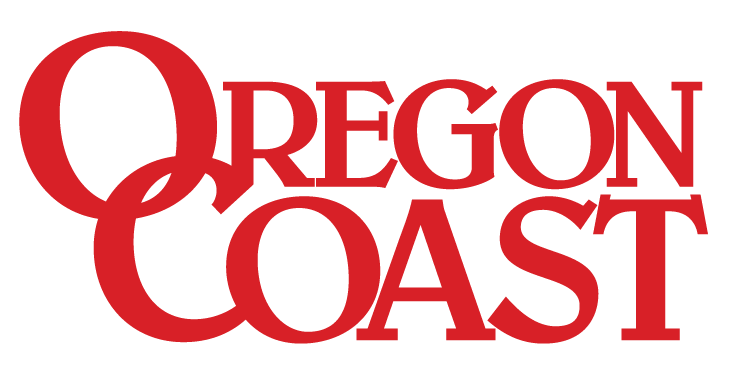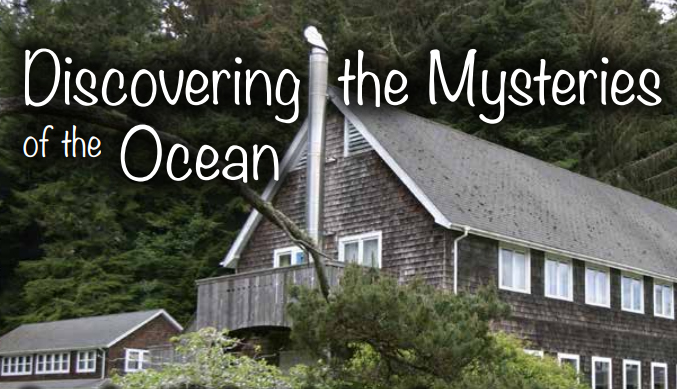STORY AND PHOTOS BY EMILY KOLKEMO/HISTORICAL PHOTOS COURTESY UNIVERSITY OF OREGON
Researchers at the Oregon Institute of Marine Biology are educating students and the public about the wonders of the ocean.
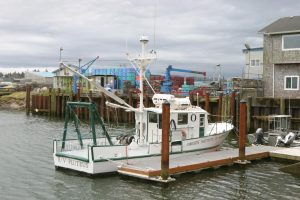
In a historic boathouse along the Coos Bay waterfront, a speaker informs the audience—a mix of university professors, students, and the general public—about the collaborative and sometimes adventurous nature of tracking Dungeness crab along the Oregon coast.
Other recent talks in this seminar series, hosted by the Oregon Institute of Marine Biology (OIMB), have explored diving among seaweed forests in the Antarctic, how waves and turbulence disperse marine larvae, and the octopus visual system, to name just a few.
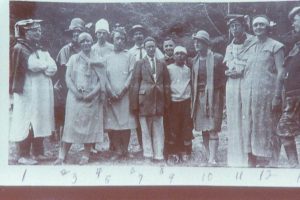
OIMB presents the seminars every spring, summer, and fall, and they are just one example of the way this marine outpost of the University of Oregon (UO) educates its students and the public about the flora, fauna, and phenomena of the ocean. (oimb.uoregon.edu/academics/seminarseries)
Another way to get to know the work of OIMB is by visiting the Charleston Marine Life Center (CMLC), located across the street from the laboratory in Charleston. The Center, which opened almost four years ago, is the public arm of OIMB, showcasing the science being done at the adjacent laboratory with exhibits on nearby marine ecosystems and inhabitants. (541-888-2581; charlestonmarinelifecenter.com)
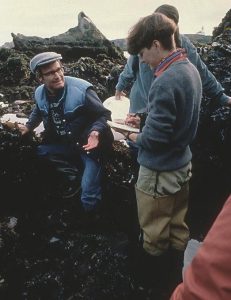
zone. Terwilliger taught classes
and was director at OIMB in the 1970s and 80s
The Marine Life Center is a new addition, but the OIMB campus and the study of marine biology on the south coast has a much longer history—one that traces back nearly 100 years.
OIMB Beginnings
“The history of OIMB has connections from mountain men to Civil War blockade ships to Nuremberg trial judges,” says OIMB director and professor Craig Young. He is alluding to the fact that the property that OIMB sits on has been a hotbed of exploration and maritime activity for a very long time. But the establishment of OIMB as an institution began to take shape in the early 1900s. According to Young, back in 1924 a couple professors from the UO took some students to Sunset Bay, set up tents for dormitories and laboratories, and taught classes and conducted research over the course of the summer.
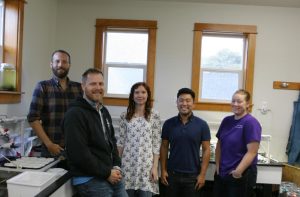
researchers inside the new Coastal Trophic
Ecology Lab
It was such a successful endeavor that by 1931, more than 100 acres of the Coos Head Military Reservation and some Army Corps buildings were deeded to the University to build the first permanent classrooms, laboratories and dormitories for summer study of the local area. Circuit Court Judge James T.Brand (who later served as a judge for the Nuremberg trials) kickstarted the effort by donating 5 acres.
World War II and some shuffling of stewardship interrupted the establishment of OIMB, but in 1955 the land and facilities were returned to the University of Oregon. By the late 1960s, the marine station was renovated into a year-round research facility.
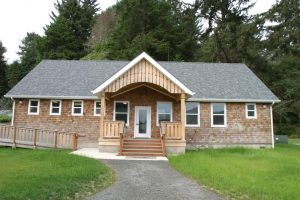
OIMB Today
Throughout the years, research at OIMB has always squarely focused on deeper understanding of the ocean. During his nearly two-decade tenure as director, Young has faithfully followed that mission. “My vision for OIMB has always been a tradition of organismal biology—how things work—focused on details of marine animals and plants,” he says.
Much of the work at OIMB explores the intricate ways in which marine organisms live in the ocean. Young’s own work involves the collection and rearing of deep-sea larvae to investigate how these animals reproduce and develop. Others study the systematics, evolution, and development of marine invertebrates (one professor is a world-expert in nemertean worms, some of which can grow to more than 100 feet in length); how jellyfish and siphonophores interact within the fluid environment of the ocean; cell division in marine animals; life histories of Dungeness crabs, and more. Their research may take them across the world, to the deepest part of the oceans, or to a tidepool just a few feet away from the station.
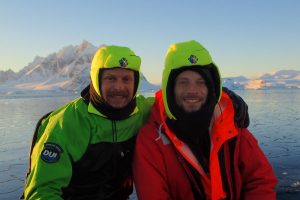
offshore of the Western Antarctic Peninsula. Photo courtesy Katrin Iken
University students come to OIMB because of small class sizes, opportunities to learn and work with world-renowned scientists, and an ideal location that is rife with opportunity to study the marine biology of ocean, bays, sloughs, and tidal flats. All of which may be why College Magazine ranked the UO/OIMB undergraduate marine biology degree as one of the top three in the U.S.
“OIMB is a unique resident field station experience where students form strong bonds with each other and small class sizes allow opportunities to interact with faculty outside of classrooms in research, internships, and projects,” says Janet Hodder, a retired senior lecturer and former education coordinator at OIMB. “You can really immerse yourself in a topic.”
A menagerie of laboratories, high-tech research equipment (including an underwater ROV and scanning electron microscopes), seawater tanks, boats (including the 42-foot oceangoing research vessel Pluteus and the smaller boat Pugettia that takes students and researchers throughout Coos Bay), and a library facilitate the research and teaching that takes place at OIMB.
But OIMB offers much more than world-class marine science experience to its students. There is a long history of educating the public as well. “Anybody can take classes at OIMB,” says Maya Watts, education program coordinator.
One class, Biological Illustration, is popular among science students, art students, those interested in professional illustration, and the general public. It evolved from a class taught in the 1960s by Lynn Rudy, who illustrated the guidebook Oregon Estuarine Invertebrates: Rudy’s Illustrated Guide to Common Species. Now, the class is taught by professional illustrator John Megahan every summer over the course of two weekends.
The OIMB campus is host to a number of annual events that are open to the public, including the Oyster Feed in April (when visitors can get behind the scenes at the lab while enjoying fresh oysters) and a concert in the boathouse in July, and is the home-base of the Oregon Shorebird Festival in September. They also have marine-related curriculum for grade K-6 available to anyone on the OIMB website (oimb.uoregon.edu/k-6/curricula).
“OIMB has a long history of reaching out to schools,” says Hodder. Besides curriculum, that outreach has included placement of OIMB students in classrooms, and most recently, opportunities for school groups to visit the Charleston Marine Life Center and learn specific topics—like the mechanics of marine mammal motion, what kinds of sharks there are off the Oregon coast, and adaptations of living in tidepools.
Future of OIMB
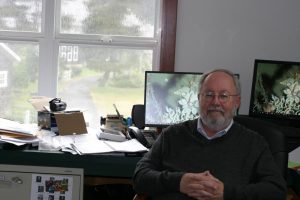
Like the bioluminescent creatures they sometimes study, the future of OIMB appears bright, with innovative research on the horizon, new and updated ways to study the ocean, and expanded opportunities for the general public to learn about the marine environment.
A new building completed last summer now houses the Coastal Trophic Ecology Lab, stocked with state-of-the art scientific equipment that helps scientists answer the question of “who eats what in the ocean.”
Led by Dr. Aaron Galloway, students and researchers in the lab are using biomarkers such as fatty acids (including omega-3 and omega-6 essential fatty acids) to study food web interactions at the base of the food chain.
It’s an important question, asserts Galloway, not just to understand feeding relationships in the ocean, but because omega-3 and -6 fatty acids are essential to the human diet. Many people think they are produced in fish such as salmon and cod, because they are commonly marketed as “fish oils,” but animals can’t make them in their own bodies.
In fact, essential fatty acids are primarily synthesized by seaweeds and phytoplankton. The molecules make their way through the food web when marine invertebrates consume algae and are then eaten by fish and crustaceans. “Seaweeds and algae are performing an underappreciated ‘ecosystem service’ for us,” says Galloway. “Algae are creating the essential molecules we need.”
There are also plans to build and outfit a new oceangoing vessel for OIMB. The vessel would replace the almost 50-year old RV Pluteus. Funding to build the vessel is currently being considered by the Oregon legislature (SB 255) and through lottery funds, and would be matched by philanthropic support.
And the Charleston Marine Life Center will continue to be a place where scientific research is revealed to visitors in exhibits and hands-on activities. A new exhibit on marine birds and shorebirds was finished earlier this year, and the center is raising funds for a future exhibit on jellyfish, cephalopods, and marine larvae (the microscopic babies of many marine animals).
“The University of Oregon’s Charleston Marine Life Center strives to open a door to the wonders of Oregon’s marine life,” says CMLC’s director Trish Mace.
In Between Pacific Tides (3rd ed.), Nobel-prize winning author John Steinbeck said, “There are answers to the world questions which every man must ask, in the little animals of tidepools, in their relations one to another, in their color phases, their reproducing methods.”
Those who work and learn at OIMB—and that includes plenty of women—are discovering the answers to those questions.
This story appeared in the Winter 2019/2020 issue of Oregon Coast magazine.
